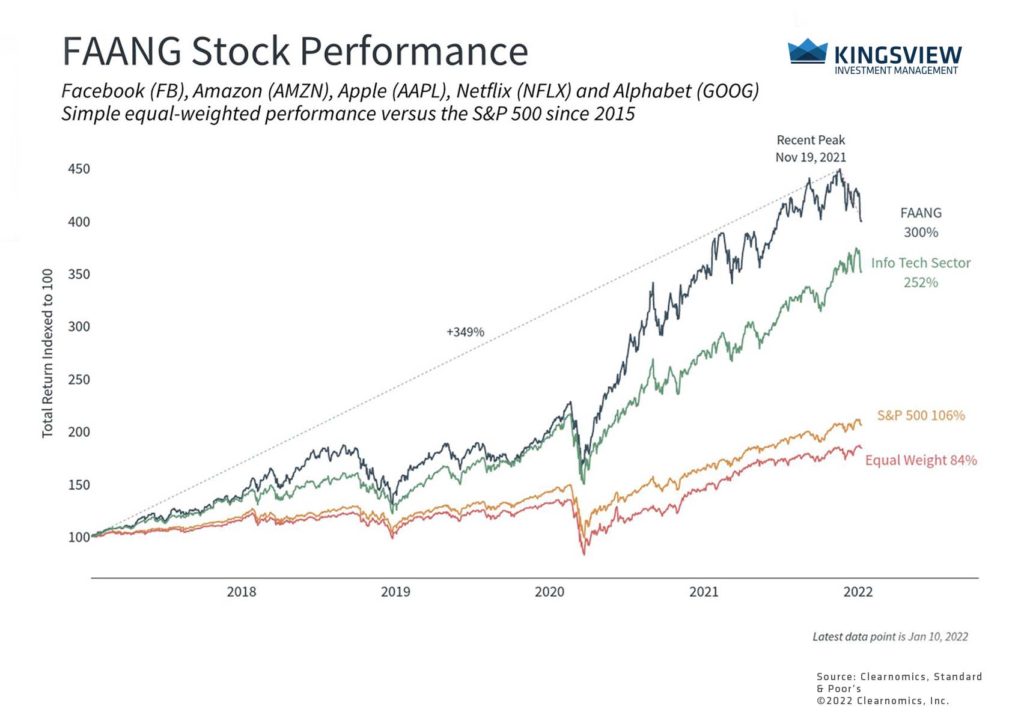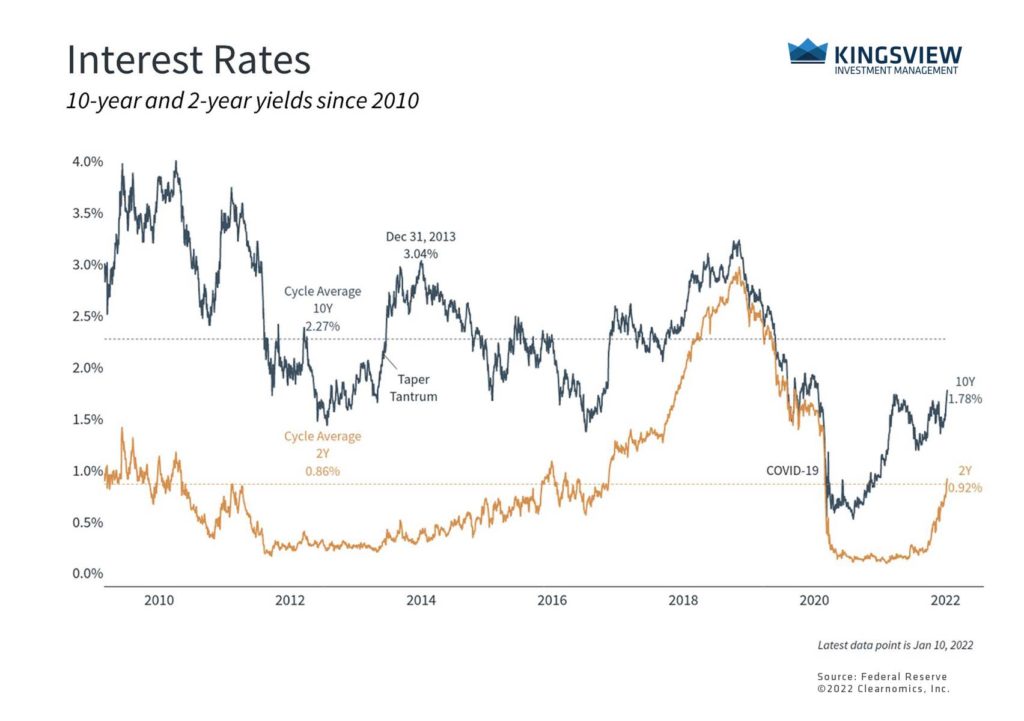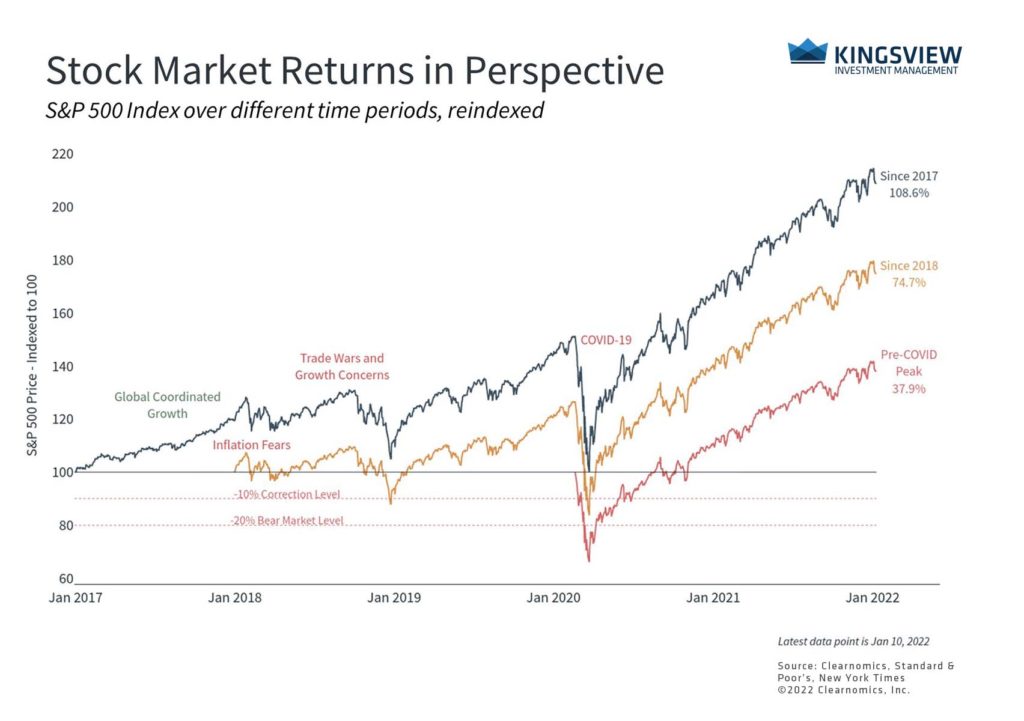Portfolio Manager Insights | Weekly Investor Commentary - 1.12.22
To download the commentary – click here.
Stocks have fallen to start the year as the prospect of a more hawkish Fed weighs on the market. Areas with high valuations such as tech have been hit the hardest with the NASDAQ Composite down several percentage points. Interest rates have jumped to nearly 1.8%, the highest since before the pandemic, in just a matter of days. When policy is shifting, it is important for investors to have the right perspective on what has truly changed and what hasn’t. In today’s market, there are at least three key facts for long-term investors to remember.
First, although the calendar has changed, the underlying economic trends have not. After all, long-term investors construct their portfolios not based on which assets have done well over recent weeks and months, but based on what will likely benefit from economic growth trends over quarters, years and decades.
Specifically, inflation is elevated just as it was for much of 2021. This is one reason investors spent months last year adjusting to a Fed taper so that when it finally happened, it was fully expected. Last week’s FOMC minutes confirmed that the central bank is worried about inflation and may thus begin to tighten faster. This will require investors to adjust once again. Still, many economists expect inflation to stabilize and perhaps decline in the second half of the year as supply chains improve and year-over-year comparisons ease.
Areas of the market like tech have fallen this year

Key Takeaway:
- Markets are adjusting to a shift in Fed policy. This is weighing heavily on areas like tech and other growth stocks. However, history shows that the onset of Fed rate hikes is typically only just the beginning for bull market cycles.
Faster Fed rate hikes may be a short-term shock to markets but they usually signal the beginning, not the end, of market cycles. It’s natural for the Fed to begin hiking rates once the economy is back on solid footing, which it has been for over a year. The fact that many are calling for rate hikes to combat inflation only further justifies these moves. The fed funds rate, which is still at zero today, reached 2.25% prior to the pandemic and even the most hawkish expectations are for the Fed to raise it to 1% by the end of 2022. History suggests that markets can perform well once investors adjust.
Second, stock market valuations in general, and growth/tech valuations in particular, are still lofty. The S&P 500’s forward price-to-earnings ratio sits at 21.7x which, although lower than at the start of the recovery, is still the highest since the dot-com era. The price-to-book ratio of U.S. growth stocks is now 10.7x compared to 4.1x for the overall Russell 3000 and only 2.4x for value stocks.
Interest rates are rising due to Fed expectations

Key Takeaway:
- Interest rates have jumped on Fed expectations. This adds to last year’s increase due to the economic recovery and inflation. Rising rates are standard as the business cycle matures.
While valuations do not predict short-term stock market performance, they do reflect expectations for what has to go right. Today’s high valuations are due entirely to the steep rise in prices over the course of this rally. However, earnings are also expected to grow quickly with S&P 500 earnings-per-share possibly reaching $220 in twelve months. As is always the case, the rapid economic recovery and robust earnings growth have been the foundations of this market cycle.
Finally, although the Fed and inflation tend to garner attention, short-term ups and downs in markets are completely normal. Even if this short-term pullback worsens, it is in the context of a significant bull rally that has lasted over 20 months. Staying patient and disciplined throughout these periods is ultimately why long-term investors are rewarded. After all, despite a never-ending list of concerns, the S&P 500 has gained 38% from the peak of the last cycle, 75% over the past 4 years, and 109% over the past 5 years. And while the past is no guarantee of the future, it is a reminder to not overreact to a few days of trading activity.
Focusing on long-term gains is the key to avoiding short-term mistakes

Key Takeaways:
- While shifts in policy naturally attract attention and result in short-term volatility, investors ought to keep these moves in perspective.
- Despite short periods of market pullbacks, including during the early stages of the pandemic, investors who have stayed patient have historically done well.
The market is adjusting to a more hawkish Fed. However, history suggests that this is both normal and positive at this stage in the business cycle.
Historical references do not assume that any prior market behavior will be duplicated. Past performance does not indicate future results. This material has been prepared by Kingsview Wealth Management, LLC. It is not, and should not, be regarded as investment advice or as a recommendation regarding any particular security or course of action. Opinions expressed herein are current opinions as of the date appearing in this material only. All investments entail risks. There is no guarantee that investment strategies will achieve the desired results under all market conditions and each investor should evaluate their ability to invest for the long term. Investment advisory services offered through Kingsview Wealth Management, LLC (“KWM”), an SEC Registered Investment Adviser. (2021)
